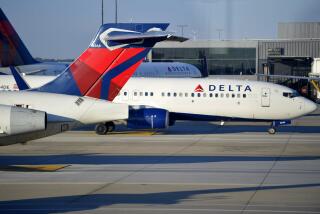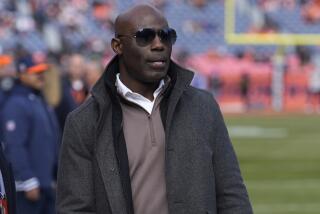Flight crews have latitude in pegging threatening behavior
After an attempted terrorist attack on a flight from Amsterdam to Detroit, the Transportation Security Administration gave airline crews new discretion to deal with threats on U.S.-bound planes.
But a recent in-flight clash over a glass of orange juice shows that not everyone agrees about what constitutes an onboard threat.
The TSA issued a directive Dec. 28 saying airline crews could decide whether to prohibit passengers from having blankets, pillows and other personal items on their laps beginning one hour before landing. The airline staff can also decide to keep passengers from getting to their carry-on baggage one hour before landing, if the crew considers it a threat to safety.
But long before the latest terrorist incident, flight crews and passengers have differed over what is acceptable behavior on a plane.
Take the orange juice incident on a Dec. 6 American Airlines flight from Sacramento to Dallas. During the flight, first-class passenger John Reed said, a flight attendant gave him a written warning that his behavior could pose a threat because he ordered a glass of orange juice.
Reed took his case to several television news shows, where he described how his request for orange juice during breakfast service prompted a loud tirade from the flight attendant.
He said the attendant told him the request was inappropriate and suggested that he must be new to first-class seating. Reed said he called her comment âcondescending.â She responded by issuing him a formal warning that he may face prosecution for interfering with a crew member.
Reed said his version of events was corroborated by several other passengers.
A few days later, an American Airlines spokesman issued a statement saying the carrier had launched a âthorough investigation of the incident.â The airline has since said the investigation continues and would not discuss any potential disciplinary action that the flight attendant may face. Reed has not been charged with a crime.
But a Federal Aviation Administration definition of in-flight threatening behavior leaves the matter open to some interpretation.
In a 2006 memo, the FAA listed four âdistinct threat levelsâ that flight crews should report to aviation officials. The threats range from âdisruptive behaviorâ to âattempted or actual breach of the flight deck.â
In the memo, disruptive behavior was described as âirrational behavior that creates the potential for physical conflict, nonviolent threatening behavior, verbal harassment, inebriation and threats (both verbal and written).â
The memo goes on to say that it is impossible to describe every behavior that could be seen as a threat. So, the advisory suggested airline staff members âuse their core concepts for response to security events.â
Passengers can disagree with flight crews over what constitutes a threat, but ultimately, FAA rules give flight crews the final say.
Under FAA regulations, âthe pilot in command of an aircraft is directly responsible for, and is the final authority as to the operation of that aircraft.â
Because the flight crew acts on the pilotâs behalf, it shares that authority.
Said FAA spokesman Ian Gregor: âIf they give you a safety-related request, you have to comply.â
Ready for a full-body scan?
The botched airline attack also prompted the TSA to require more thorough screening of passengers.
After the incident, the TSA announced it planned to order 300 full-body image screening machines, in addition to 150 units that the TSA had already scheduled to install at airports nationwide early this year.
Airline trade groups and business travel associations complained that airport security hassles could damp demand for air travel, just as the travel industry was showing signs of recovering from a yearlong slump.
âWe must find new screening techniques that strengthen security, protect privacy and reduce wait times and other hassles for travelers,â said Roger Dow, president and CEO of the U.S. Travel Assn., a nonprofit group that promotes travel in the U.S.
The length of delays, TSA officials said, might ultimately depend on how many passengers must go through the full body scan, and how many opt instead for the manual pat-down search.
Currently, it takes about 10 seconds for the average person to walk through a metal-detector scanner, the TSA said. (This does not include the time it takes passengers to remove shoes, belts, etc., run carry-on baggage through an X-ray screening unit, collect their belongings and get redressed.)
Security screeners and airline officials can then decide whether a passenger needs to go through one of the full-body screening units, which are capable of scanning one person every 12 to 15 seconds, according to the TSA.
But some passengers are likely to balk at entering these units, which create what looks like a nude image of their bodies. For those who object, the alternative is to submit to a pat-down search by security agents, which takes an average of three to five minutes, the TSA said.
Now do the math.
Assume you are flying on a jet that seats 300 passengers. In the best-case scenario, screening all 300 through a typical metal detector, barring any snafus, should take as little as 50 minutes. That is assuming no passengers set off an alarm because they forgot to remove belt buckles or rings of keys.
In the worst-case scenario, TSA screeners could require all 300 passengers to pass through a full-body image screener and every passenger could opt for a pat-down search. Under this scenario, the screening process for the flight should take up to, ugh, 25 hours.
Far-fetched? Yes. Still, is it any wonder the airlines always remind passengers to get to the airport early?
More to Read
Inside the business of entertainment
The Wide Shot brings you news, analysis and insights on everything from streaming wars to production â and what it all means for the future.
You may occasionally receive promotional content from the Los Angeles Times.










